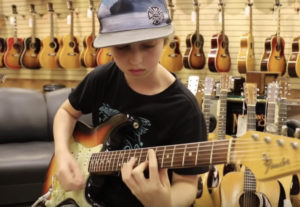
[YouTube capture: 12-year-old Jaden Lehman]
Have you ever felt like you’re stuck in a rut? Sometimes, all you need is a slight detour to nudge your playing in a new direction. The following concepts may seem lighthearted or absurd at first, but if you put some time into them, you’re sure to come away with something fresh.
Open Your Mind with an Open Tuning
Goals: Songwriting, Ear training. If you have an unused guitar lying around—acoustic or electric—tune it to an open chord and spend some time exploring it intuitively. Don’t worry whether you’re using this new tuning “correctly.” Just play, and let your ears guide you until riffs or songs appear under your fingers. Common tunings include [from low string to high]: DADF#AD, DADGAD, and DGDGBD.
A good way to begin is by playing standard chord shapes in the new tuning, such as G, C, D, Em, A7. Try playing them in different areas of the neck, and keep track of the ones that sound good to you. If you’re working with an electric guitar in an open tuning, check out how it sounds through your favorite pedals, and at various volume levels. Sometimes, a little gain is all the inspiration you need to find a new song in an exotic tuning. If you’re feeling really adventurous, check out the tunings Sonic Youth uses for some of their songs here.
Pro Tip: Whenever possible, tune your strings down to avoid breaking them. Then, use a capo if you want to change to a higher key. If you plan to tune your strings significantly lower, consider putting heavier gauge strings on the instrument.
The Blindfold Test
Goals: Build confidence, Find inspiration. Once my students have a repertoire of scales and riffs under their fingers, I give them the Blindfold Test. With their eyes covered, I ask them to play through the material they’ve recently learned. This not only reduces their need to look at the fretboard, it helps them play more intuitively and with less fear of making mistakes. I use Luke Skywalker’s lightsaber lesson from Star Wars as a metaphor: In the film, Obi-Wan tells Luke “Let go your conscious self and act on instinct.” The idea here is for students to learn to trust their muscle memory as they visualize the fretboard in their mind. Spend time playing your favorite songs, chord progressions, and scales with your eyes closed, and you’ll be surprised how quickly you learn to navigate your guitar by feel. And don’t worry if you play some unintended notes now and then. They might reward you with a new riff or lick!
Learn the Music You Hate
Goals: Broaden your skills, Ear training. You read that right: Pick a song, album, or musical genre you dislike and dig into it. The goal is to figure out how it works on a technical, as well as a sonic level. Why? Because even the simplest guitar part in a corny tune can be challenging to play well. If you give lessons, a wider knowledge of guitar styles may help you attract new students. And knowing more styles can provide gigging opportunities in the future. Moreover, by examining the guitar tone and how it fits into the mix, you may learn some useful tricks for your own records. Don’t be surprised if, by the end of this exercise, you begin to enjoy the music you previously hated—or, at the very least, have a greater respect for the musicians playing it.
Jam with the Radio
Goals: Ear training, relaxation while woodshedding. Part of the daily practice regimen of avant-garde guitarist Derek Bailey involved playing along with whatever song come up on the radio (pop, R&B, rock, country, etc.). It not only helped him keep his chops up, but stretched his ear, as well. This exercise also provides an inspiring way to improvise, because you never know what the next song will be—especially if you tune into a station that plays music you don’t normally listen to. And like many games of skill, you’re up against the clock. You only have a few minutes to work with each song before a new one arrives.
When I do this exercise, I start by identifying the main key and chord progression of the tune, and go from there. I might run scales or arpeggios over the song (using it like a metronome for my regular practice routine), or come up with my own parts that fit into the arrangement, such as counter melodies, chord inversions, and so on (some of which I’ll keep for my own music). In fact, the ability to come up with new parts quickly is an excellent skill to have if you are interested in doing session work.



